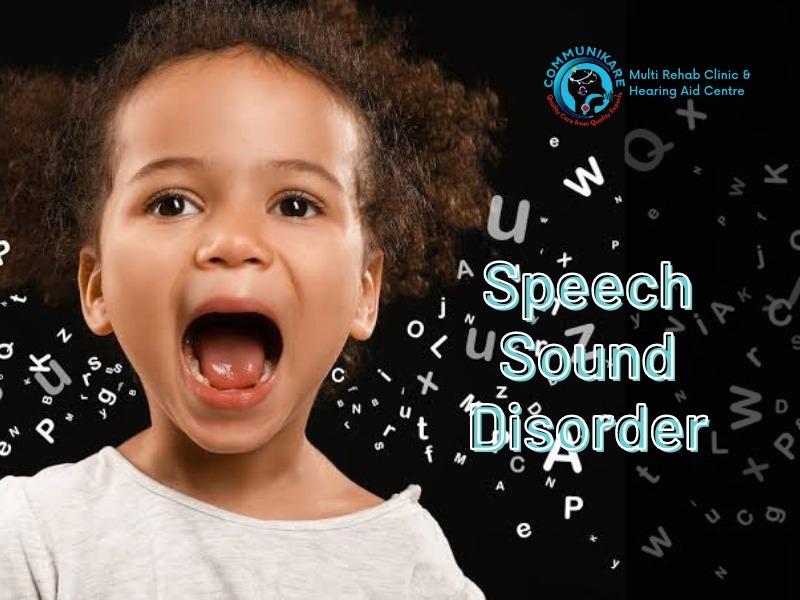Speech Sound Disorder
Admin
December 20, 2022

Speech Sound Disorder
Speech Sound Disorder is common for young children learning language to have some
difficulty pronouncing words correctly. Their communication skills improve over time. At
each age, they master specific sounds and words. By age 8, the majority of children have
mastered all word sounds.
However, some youngsters have speech sound problems. This indicates that individuals
have difficulty pronouncing particular sounds and words beyond the expected age. This can
make it difficult to comprehend what a child is attempting to communicate.
Problems with speech sounds include articulation and phonological process disorders.
- Articulation disorder is a difficulty producing particular sounds, such as “sh.”
- Phonological process disorder is an occurrence of sound errors. This includes the
omission of letter pronunciations.
Symptoms of Speech Sound Disorder
A speech sound issue can express itself in a variety of ways. This typically depends on the
circumstances causing the difficulty or its severity.
There are various mistake patterns that may indicate a speech sound issue. These consist of
- Stuttering
- Elimination of a sound from a word
- Having a sound within a word
- Substituting difficult to pronounce sounds with inappropriate alternatives
- Difficulty pronouncing the identical sound in several words (e.g., “pig” and “kit”)
- Repetitive sounds or phrases
- Lengthening language
- pauses while speech
- Tension during sound production
- Head jerks while talking
- Speaking while blinking
- While conversing with
- Variations in vocal pitch
- Raspiness
- Experiencing difficulty with speaking
It is essential to recognize that children develop at varying rates. This might manifest itself in
the ease and capacity to create sounds. However, when children consistently create
difficult-to-understand noises or statements, this may suggest a speech impairment.
Identifying Speech Sound Disorders
A speech-language pathologist can identify whether or not a kid has a speech-sound issue
for an accurate diagnosis.
- The youngster persists in having problems producing sounds This has an effect on
communication and speech comprehension - Symptoms of the disease manifest early in a child’s development.
- This condition hinders communication. It impacts social interactions, academic
accomplishments, and occupational performance. - The problem is not the result of a congenital disorder or an acquired ailment, such as
hearing loss. However, inherited illnesses are exempt.
Children at risk for a speech sound issue include those with the following conditions:
- Disorders of development such as autism
- Genetic conditions like Down syndrome
- Hearing impairment
- Cerebral Palsy – Nervous System Disorders
- Frequent illnesses such as ear infections
- Malformations of the body, such as a cleft lip or palate
- An excessive amount of thumb-sucking or pacifier use
- Low parental level of education
- Lack of parental support for learning
Reasons for Speech Sound Disorders
It is unknown what causes speech sound abnormalities. Nonetheless, a number of risk
factors may raise the likelihood of acquiring a speech disorder. These consist of:
Male children are more prone to develop a speech sound issue than female ones.
Children with a family history of speech difficulties may develop a similar disorder
themselves.
- Socioeconomics: Growing up in a low socioeconomic setting might contribute to
speech and literacy difficulties. - Prenatal and postnatal difficulties: Obstacles encountered during pregnancy, such
as maternal infections and stressors, may increase the likelihood that a child would
develop speech impairments. Similarly, delivery problems, prematurity, and low
birth weight may result in speech impairments. - Disabilities: Down syndrome, autism, and other impairments may be associated
with speech-sound abnormalities. - Physical challenges: Children with a cleft lip may have trouble producing spoken
sounds. - Brain Injury: These problems may also be caused by an infection or traumatic brain
injury in children. This is observed in disorders such as cerebral palsy, in which the
speech-affecting muscles are damaged.
Different Types of Speech Sound Disorders
At least half of everything a three-year-old youngster says should be adequately understood.
By the ages of four and five, most sounds should be pronounced correctly, with the
exception of “l”, “s”, “r”, and “v” and other comparable sounds. By the age of seven or eight,
difficult sounds should be properly articulated.
Even after the typical age, a kid with a speech sound impairment will continue to struggle
with word pronunciation. Patterns of difficulty with speech may indicate one of the
following speech sound disorders:
Disfluency
Stuttering is the most prevalent form of disfluency. It is characterized by frequent
interruptions in the natural flow of speech. This refers to speech interruptions.A youngster
with disfluency will continue to repeat words or phrases after the age of four. This child may
use extra words or noises when talking; they may also emphasise syllables to lengthen
words.
This disorder may create speech stress. Occasionally, disfluency may be accompanied by
head jerking or blinking.
Children with this disease frequently experience frustration when speaking, and it may also
lead to social shame.
Articulation Problems
When a youngster is unable to create sounds correctly, this may be the result of inaccurate
placement, speed, pressure, or movement of the lips, tongue, or throat.
This typically indicates an articulation issue in which sounds such as “r”, “l”, and “s” are
altered. In such circumstances, only close family members may comprehend the child’s
message.
Phonological Disorder
A phonological disorder exists when a youngster cannot produce the age-appropriate
spoken sounds. There may be errors in the production of sounds. On occasion, consonant
sounds may be missing when speaking.
Voice Disorder
Observing a child with a raspy voice may be an early indicator of a vocal issue. Other signs
include speech breaks, a shift in pitch, and a voice that is either too loud or soft.
Children who experience shortness of breath when speaking may also be affected by this
disease. Similarly, children with a vocal condition may sound very nasal or as if they have
insufficient air coming out of their nose.
Apraxia
Apraxia of speech in childhood happens when a youngster lacks the necessary motor
abilities for sound production. Children with this disorder will struggle to plan and execute
the tongue, lips, jaw, and palate movements essential for speaking.
Treatment for Speech Sound Disorder
The next steps for parents of children with speech sound abnormalities may be unclear. To
minimize adding to the child’s stress, it is essential to avoid displaying undue concern.
Instead, attentively listening to their needs, allowing them to talk without completing their
sentences, and demonstrating normal affection and concern can go a long way.
A speech-language pathologist can enhance a child’s communication with expert assistance.
Typically, these pathologists will employ oral motor exercises to improve speech.
These oral exercises may also consist of non-speech oral exercises such as blowing, oral
massages, and brushing, cheek puffing, whistleblowing, etc.
Oral exercises that do not include speaking strengthen weak mouth muscles and aid in the
acquisition of standard modes of communication.
In addition to joining support groups for information and assistance, parents and children
with speech, and sound abnormalities may also join such groups.
It might be frustrating to observe communication difficulties. However, while it is fair to
desire normal communication from a child, speech difficulties can be controlled with the
proper care and supervision. Communicating with a speech therapist and demonstrating
affection for children with speech difficulties can be crucial first steps in conquering these
conditions.



Categories

We Care for Your communication,
Quality Care from Quality Experts.
Quick Links
Subscribe Our Newsletter
You’ll receive regular updates on our special offers, and other exciting news.
www.communikare.in